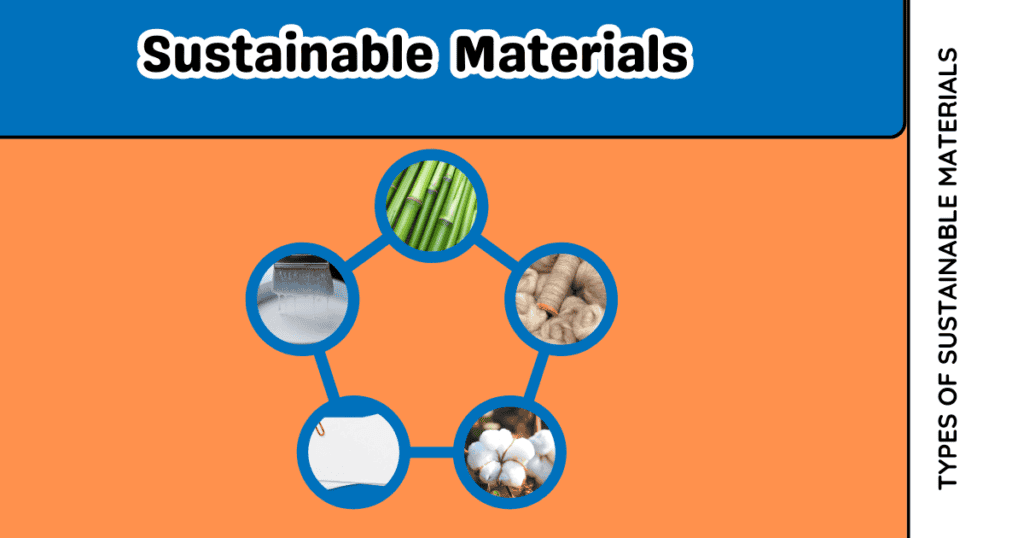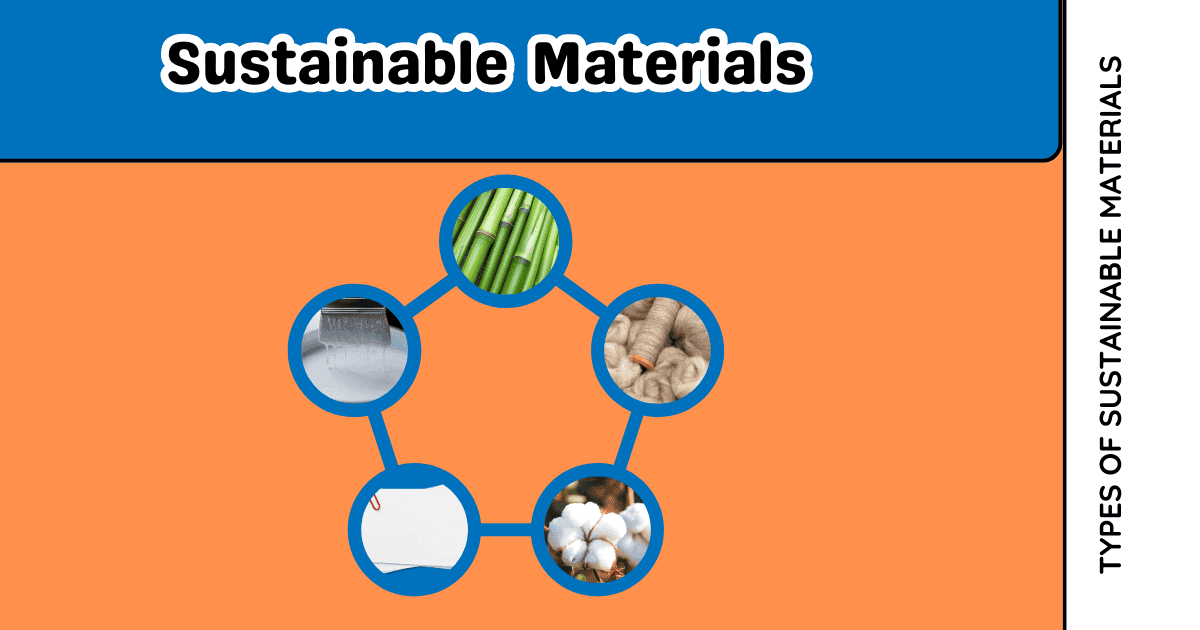In an age imperiled by environmental degradation, where the persistent churn of consumption takes an increasingly heavy toll on the planet, the quest for sustainable solutions becomes urgent. Materials play a pivotal role in this narrative, often the unsung heroes of a healthier world.
This comprehensive exploration charts the importance of sustainable materials in the grand scheme of environmental sustainability, shedding light on their types, impacts, innovations, and practical applications.
Introduction to Sustainable Materials
Sustainable materials or ‘green materials’ refer to resources that have a reduced environmental impact throughout their life cycle compared to conventional alternatives. These can include renewable and biodegradable materials such as bamboo, wool, and cotton; recycled materials like paper, glass, and metal; and non-toxic materials like natural dyes and water-based paints. By using these materials, we can significantly reduce the negative impacts of production, use, and disposal on the environment.
At the heart of this eco-conscious paradigm shift are sustainable materials — resources that meet present needs without compromising the ability of future generations to meet their own. Such materials are not a mere trend but a fundamental component of the stewardship the Earth urgently requires.
Why Are Sustainable Materials Vital?
Sustainable materials offer an escape from the linear consumption model, which extracts, consumes, and discards resources in perpetuity. They advocate for a circular economy, where materials are continually looped back into the manufacturing process, promoting longevity, reduction in waste, and preservation of natural resources.
By reducing energy consumption, emissions, and pollutants, sustainable materials help mitigate climate change and protect ecosystems. They also support ethical values by promoting fair labor practices and minimizing the exploitation of workers.
Types of Sustainable Materials
Sustainable materials encompass various categories of resources, each with specific traits that make them environmentally friendly. These include biodegradable materials, renewable materials, recycled materials, and non-toxic materials.

Each type has its own unique benefits and applications, but all share the common goal of reducing harm to the environment. Biodegradable materials, for instance, decompose naturally and do not harm the environment during disposal.
There are several key categories of sustainable materials:
1. Biodegradable Materials
Biodegradability marks a milestone in the life cycle of materials. Items crafted from biodegradable materials can return to the earth safely within a relatively short time frame, typically by the action of microorganisms. The benefits are manifold, from reducing landfill pressure to preventing soil and water contamination.
Examples and Benefits
- Bioplastics: Derived from renewable plant sources like corn and sugarcane, bioplastics hold the promise of plastic utility without the eternal ecological footprint of conventional plastics.
- Natural Fibers: Materials such as hemp, bamboo, and jute offer versatile alternatives to synthetic fibers, boasting sturdy, biodegradable properties.
2. Recycled and Upcycled Materials
Recycling and upcycling are potent tools in the sustainability arsenal. By reprocessing used materials into new products or materials of higher quality, both recycling and upcycling help to close the consumption loop.
Examples and Benefits
- Recycled Plastics: Companies are leaping toward the use of plastics derived from recycled content, turning waste materials into fresh, useful products that contribute to a cleaner planet.
- Upcycled Textiles: The fashion industry is innovating with textiles created from pre-existing materials, offering style with a lower environmental impact.
3. Renewable Materials
Renewable materials are those sourced from natural elements that can be replenished at a rate equal to or faster than their rate of use. These resources are the cornerstones of a sustainable economy.
Examples and Benefits
- Timber and Wood Products: Sustainably harvested timber ensures forests can regenerate, providing a perpetual supply of wood for various applications without deforestation.
- Solar Energy Materials: Photovoltaic technology harnesses the sun’s energy using materials that require minimal environmental inputs and produce renewable electricity.
The Impact of Sustainable Materials
The consequences of unsustainable materials are vast, and their impacts are far-reaching. Inefficient production processes, overconsumption, and improper waste management contribute to the depletion of natural resources, pollution of land and water, and endangerment of biodiversity.
Unsustainable materials also have a significant carbon footprint, contributing to climate change by releasing greenhouse gases into the atmosphere. The negative effects on human health and ecosystems are evident, and without a shift towards sustainable materials, these problems will continue to worsen.
Environmental Benefits
The most immediate impact of sustainable materials is on the environment. By reducing the extraction of virgin resources and lessening the amount of waste that ends up in landfills or natural ecosystems, these materials help protect biodiversity, conserve energy, and mitigate climate change.
Case Studies
- Patagonia’s Recycled Polyester Jackets: Patagonia’s investment in sustainable materials is evident in its range of clothing items incorporating recycled materials. This initiative not only benefits the environment but also educates consumers about the possibility of sustainable fashion.
- The Boring Company’s Tunnel Technology: Elon Musk’s tunnel construction venture is a visionary example of sustainable materials in action, utilizing recycled elements to create infrastructure in a resource-responsible manner.
Social and Economic Impact
Beyond ecological benefits, sustainable materials can bolster local economies and improve the lives of communities, particularly in developing nations with rich natural resources.
Case Studies
- IKEA’s Community Wood Initiatives: By supporting programs that promote responsible forestry and craftspeople, IKEA ensures that the materials they use benefit both the environment and society.
- Interface’s Recycling Partnerships: Interface’s commitment to resource efficiency is a model for corporate social responsibility, fostering partnerships that not only source sustainable materials but also contribute to a circular economy through initiatives like Net-Works, which repurposes discarded fishing nets.
Innovations in Sustainable Materials
Innovations in sustainable materials are constantly pushing the boundaries of what is possible, offering new and exciting solutions to global environmental challenges. From revolutionary changes to existing materials, like the development of biodegradable plastic alternatives, to entirely new inventions, such as self-healing concrete, these innovations continue to transform industries and inspire a more sustainable mindset.
Nanotechnology
Nanotechnology, the manipulation of matter at an atomic or molecular scale, has brought about significant advancements in sustainable materials. It has allowed for the creation of stronger and more durable materials using fewer resources, as well as the development of new properties such as water and stain resistance. Applications range from eco-friendly building materials to lightweight and energy-efficient electronics.
3D Printing
3D printing, also known as additive manufacturing, has been gaining traction in the production of sustainable materials. This technology allows for precise and efficient use of resources, reducing waste during the manufacturing process.
It also enables the creation of complex and customized designs using a variety of materials, including recycled ones. The potential for 3D printing to revolutionize industries such as construction and healthcare is immense, offering sustainable solutions to current challenges.
Sustainable materials play a vital role in promoting environmental sustainability and mitigating the harmful effects of traditional manufacturing processes. From biodegradable and renewable materials to innovative technologies like nanotechnology and 3D printing, sustainable materials offer endless possibilities for creating a more environmentally responsible future.
Practical Applications of Sustainable Materials
The use of sustainable materials goes beyond just reducing environmental impact; it also offers practical benefits for individuals, businesses, and society as a whole. From cost savings to improved health and safety, the adoption of sustainable materials is proving to be a win-win situation for all stakeholders involved.
Cost Savings
The use of sustainable materials can lead to significant cost savings for businesses and individuals. For example, using renewable energy sources instead of non-renewable ones can reduce energy costs in the long run. Similarly, utilizing recycled materials in production processes can result in lower material costs and waste management expenses.
Health and Safety
Sustainable materials also offer health and safety benefits for both humans and the environment. For example, using biodegradable materials in food packaging reduces exposure to harmful chemicals found in traditional plastics. Using sustainable materials also supports a cleaner environment, which can lead to improved public health.
Social Impact
The adoption of sustainable materials has a positive social impact as well. It creates job opportunities in industries such as renewable energy and sustainable agriculture, promoting economic growth. It also encourages responsible consumption and production practices, leading to a more sustainable society.
The use of sustainable materials is integral to achieving environmental sustainability. From biodegradable and recycled materials to renewable resources and innovative technologies, the potential for these materials to create a greener future is vast. By harnessing these materials and their practical applications, we can create a more sustainable world for generations to come.
Read: What Innovation Changed the Textile Industry?
Challenges and Future of Sustainable Materials
The path to a sustainable future is not without obstacles. The adoption of sustainable materials faces challenges ranging from cost to consumer education and infrastructure limitations. Yet, the horizon is rich with potential as stakeholders collaborate, and technology evolves.
Overcoming Obstacles
To realize the full potential of sustainable materials, concerted efforts are necessary to address issues related to regulation, investment, and cultural norms.
Collective Solutions
- Policy Initiatives: Proactive policies and incentives can spur the adoption of sustainable materials, rewarding businesses that prioritize environmental stewardship.
- Public Awareness Campaigns: Education and outreach are vital tools to cultivate a consumer base that demands and supports sustainable alternatives.
Tomorrow’s Sustainable Materials
The innovation pipeline for sustainable materials is overflowing with possibilities! As we move forward, here’s a peek at what the future holds for this exciting field:
- Biomimetic Marvels: Nature has always been the ultimate engineer. Imagine buildings mimicking termite mounds for natural temperature regulation, or self-healing materials inspired by the regenerative powers of lizards. Biomimicry will play a key role in designing sustainable materials with superior functionality and lower environmental impact.
- Rise of the Machines: Automation and artificial intelligence (AI) will revolutionize sustainable material production. AI can optimize complex processes, minimize waste, and even design new materials with previously unforeseen properties. This will lead to more efficient and eco-friendly manufacturing.
- A Circular Economy Takes Root: The concept of a circular economy, where materials are reused and recycled endlessly, will become mainstream. Imagine buildings constructed from prefabricated, recycled components, designed for disassembly and re-use in future projects. Sustainable materials will be engineered for repairability and adaptability, reducing our reliance on virgin resources.
- Mushrooms Take Over (Not Really, But Almost!) Mycelium, the root network of fungi, is emerging as a game-changer. Mycelium-based materials are not only biodegradable but also hold promise for insulation, packaging, and even construction applications. Research suggests they can even be used to purify polluted environments!
- A Material World, Reimagined: The future of sustainable materials isn’t just about replacing existing ones. We can expect entirely new categories of materials with unique properties. Imagine fabrics that capture and convert solar energy to power wearable electronics, or self-cleaning surfaces that eliminate the need for harsh chemicals.
This glimpse into the future paints an optimistic picture. By embracing innovation and collaboration, sustainable materials have the potential to revolutionize the way we build, consume, and interact with the world around us. Stay tuned for further explorations into this exciting realm!
Conclusion
Sustainable materials are not just a buzzword; they are the fabric of a greener, more resilient planet. From the battlefields of waste reduction to the frontier of material science, their significance is unambiguous.
It is through their adoption and proliferation that we lay the groundwork for a future where resource use is married to the rhythms of the natural world, ensuring a legacy that future generations will cherish. The time to act is now, and sustainable materials are the keys to unlocking our collective potential for a healthier, more harmonious world.


